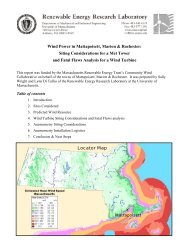Erickson-Indiana-bat
Erickson-Indiana-bat
Erickson-Indiana-bat
Create successful ePaper yourself
Turn your PDF publications into a flip-book with our unique Google optimized e-Paper software.
METHODS<br />
We used a FAC model to explore potential impacts of wind energy development on the<br />
<strong>Indiana</strong> <strong>bat</strong>. Our model included data from multiple sources, including habitat and wind<br />
turbine data (Fig. 1). We described our model using the Overview, Design Concepts, and<br />
Details protocol (Grimm et al., 2006; Grimm et al., 2010) as part of our transparent and<br />
comprehensive model ‘‘evaludation’’ (TRACE) documentation (Schmolke et al., 2010; Augusiak,<br />
Van den Brink & Grimm, 2014; Grimm et al., 2014) (Supplemental Information 3).<br />
We also include our code as Supplemental Information 4 and our data have been published<br />
to a USGS webpage (<strong>Erickson</strong>, 2016). Within the remainder of this section, we provide an<br />
overview of our modeling approach and description of the data used within this approach.<br />
The core of our population model is a series of difference equations (previously described<br />
in <strong>Erickson</strong> et al. (2014) and listed in our TRACE documentation). The model keeps track<br />
of groups of female <strong>Indiana</strong> <strong>bat</strong>s using a pathway between a hibernaculum and a maternity<br />
colony. <strong>Erickson</strong> et al. (2014) formulated the model to include density at both maternity<br />
sites and hibernacula following Taylor & Norris (2010). We modified the model to only<br />
include density at the maternity colonies, which affected a baseline survival rate. We made<br />
this modification because hibernacula are unlikely to be limiting the Indian <strong>bat</strong> population<br />
sizes. Specifically, the total <strong>Indiana</strong> <strong>bat</strong> population appears to be at least one order of<br />
magnitude lower than pre-European settlement sizes and the number of hibernacula has<br />
remaining relatively stable or increasing through time as <strong>bat</strong>s colonize old mines (Pruitt &<br />
TeWinkel, 2007).<br />
We based our life history parameters upon previous models (Thogmartin et al., 2012b;<br />
<strong>Erickson</strong>, Thogmartin & Szymanski, 2014) and selected parameter values so that the annual<br />
population growth rate was 1.02 without the density effect. This value is concordant with<br />
pre-WNS growing <strong>Indiana</strong> <strong>bat</strong> populations (Thogmartin et al., 2013; Thogmartin et al.,<br />
2012a; Thogmartin et al., 2012b).<br />
Our model landscape covered much of the eastern United States (Fig. 1). The landscape<br />
was divided into approximately 33,000 6500-ha grid cells because this resolution is<br />
considered to be equivalent to the home range area of an <strong>Indiana</strong> <strong>bat</strong> maternity colony<br />
by the USFWS (J Szymanski, pers. obs.). Furthermore, all hibernacula in close proximity<br />
(



